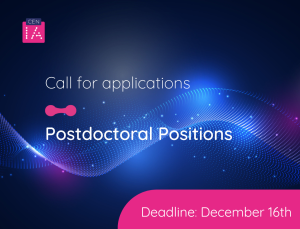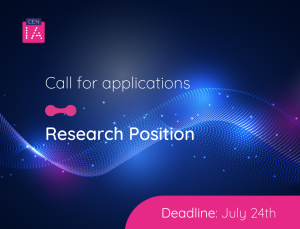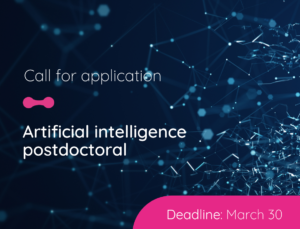
María José Escobar, an electronic civil engineer, research collaborator, associate researcher at the National Center for Artificial Intelligence, associate researcher at the Advanced Center for Electrical and Electronic Engineering (AC3E) and academic at Universidad Técnica Federico Santa María, has succeeded in making these devices learn movements, based on her study of neural networks.
The expert emphasizes that the study of the nervous system, particularly the brain, provides inspiration on how sensory information is handled and processed for decision making or the generation of actions.
Artificial intelligence (AI) and knowledge of our brain are becoming increasingly intertwined, giving way to novel developments. Among these, there is the development of algorithms for handling robots developed by a Chilean scientist, who seeks inspiration in certain human behaviors. María José Escobar, electronic civil engineer, research collaborator, associate researcher of the National Center for Artificial Intelligence, associate researcher of AC3E and academic of the Universidad Técnica Federico Santa María, has managed to make her devices learn movements, based on her study of neural networks. Her work will be presented this Thursday at the Future Congress, in Block 18, “Connecting the Black Box.”
Her presentation will focus on the relationship between neuroscience and artificial intelligence and also with the so-called cognitive robotics, which is trying to make algorithms for robots that are inspired by some cognitive process observed in humans.
According to the specialist, the advance of AI, machine learning and neural networks is very fast. An example of a major breakthrough is the AlphaFold program, which can very accurately predict the 3D structure of a protein from a chain of amino acids. “This opens up unparalleled horizons in the understanding of life, how our bodies work, or the design of new medicine. On the other hand, we have recently been amazed by ChatGPT, which establishes dialogs and could easily challenge the Turing test used to measure the performance of artificial intelligence algorithms,” she says.
“Spider” Robot
The Cenia and AC3E researcher, together with her team, has created algorithms to handle specialized robots, similar in shape to a spider, but actually with four legs and not eight, unlike the insect. The central idea of her project is to make the devices move from one point to another by means of a set of instructions or rules (algorithm). She emphasizes that their interaction with their environment is key to determine the sequence of movements that make up their walk. That is, they are able to identify the shape of their body in order to achieve a good displacement.
The researcher explains that, unlike other classic robotics technologies, this one does not provide the algorithm with information about the robot’s morphology, but rather it is “inferred” from the action of its own actuators, which are the engines that make up its legs. Thus, this spider can know how it is itself, through movement. “Developing instructions with this approach provides more flexible solutions to possible changes in the environment or in the composition of these machines, allowing the algorithm to adapt to this new context, without the need to mathematically model the new scenario,” she explains.

Escobar says she is also working with a humanoid robot developed by IIT (Italy), “iCub”, to learn more about AI. “It’s like a three-year-old, with an extensive amount of sensors and actuators. On this platform we are developing an algorithm that allows the robot, by tactile exploration of itself, to build a mathematical model of what its body is. If you change its clothes, it can know what shape it is and move in some spaces without colliding or acting in a better way with a person,” she explains.
Brain and replication
“The study of the nervous system, in particular the brain, provides inspiration on how sensory information is handled and processed for decision making or the generation of actions,” summarizes the engineer. According to their analysis, on the one hand, it allows us to understand how to process data efficiently and which characteristics are or are not important for a particular task. She also emphasizes that the study and relationship between different cortical structures for certain cognitive tasks “can be used for the design of artificial neural networks used in similar tasks, such as, for example, memory,” she says.
As a result of these observations and studies, she worked with her team to generate algorithms for walking spider robots. As for a more specific sensory system, such as visual, she says that an artificial retina can be trained with the data captured from the rodent retina, thus providing a highly efficient and effective artificial visual sensor for extracting information from visual scenes.
Maximizing information
For the researcher, one of the major problems facing AI today is the large amount of computing required to train its algorithms, which is reflected in the large energy consumption of the servers that run these training instructions. “The problem is further exacerbated if these servers are located in places where the energy supply comes from non-renewable sources, such as China,” she notes.
In the case of the human brain, it is highly efficient in energy consumption, mainly “because it processes information asynchronously (only when there is something to process and not all the time, like a conventional computer), and because the information is encoded in a series of electrical impulses called action potentials,” emphasizes Escobar. Therefore, she argues, having electronic systems that work with these principles, such as neuromorphic systems (modeled computing, through the study of the nervous system and the brain), could reduce the energy consumption of many algorithms.
By: Cristián Yáñez W. Agencia Inés Llambías Comunicaciones.







